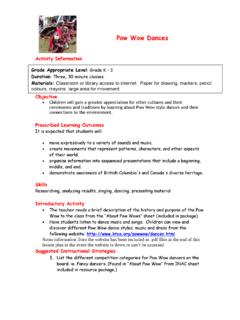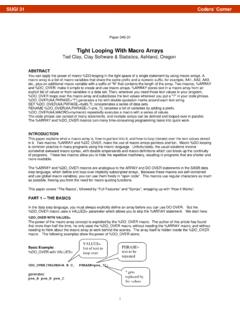Transcription of Legends of our Time4 - ForedBC
1 Legends of our Time Activity Information Grade Appropriate Level: Grade 4-7 Duration: 2 forty-minute class periods (homework may need to be assigned to complete this writing assignment) Materials: floor space, chalkboard or chart paper, chalk or large marker, 1 copy of each of 7 Legends enclosed in package, classroom dictionary, and for each student a pencil, work sheet, paper to write (or type) a story and a self-evaluation and peer- evaluation form Objective The purpose of this lesson is to foster in students a deeper understanding and appreciation for First Nations Legends , stories and storytelling. The lesson will provide them with background knowledge to write their own legend and to practice their presentation skills in a storytelling group. Note: This lesson was designed to precede Masks, Bringing a legend to Life, the art lesson that is enclosed in this package.
2 Prescribed Learning Outcomes English Language Arts, Social Studies, Personal Planning Demonstrate pride and satisfaction in using language to create and express thoughts,ideas, and feelings in a variety of oral, written, and electronic forms Apply the basic rules and conventions of writing or speaking for the oral, visual, andwritten forms they select Demonstrate confidence in their abilities to communicate effectively in a variety ofclassroom situations Revise and edit their own work for content and clarity Appraise their own and others' work and make suggestions for revision Express ideas and emotions using verbal and non-verbal communication Demonstrate awareness and appreciation of various Aboriginal cultures in Canada Demonstrate appreciation of contributions of Aboriginal peoplesIntroductory Activity Open the lesson with a class discussion about Legends .
3 On a chalkboardor chart, write Legends in the center of a large space and ask studentsto share ideas about what that word means. As they offer their ideas, writethem onto the chalkboard surrounding the center area. The goal is tobrainstorm a variety of accurate describing words that will help to definewhat Legends are. Once the students have offered several descriptors, go back through themone by one and determine aloud which words should stay and whichshould be erased or crossed out. Students can help you make thesechoices by justifying their answers. Finally, have a student read aloud the definition of legend from a classdictionary. An example from an Oxford Dictionary reads: legend - story(true or invented) handed down from the past, myth; such storiescollectively Check back to see if any student ideas wereaccurate.
4 At this time, ask the students if theyknow of any popular Legends that they couldbriefly describe. As students share theirthoughts, ensure that they can justify why theirstory fits into the legend description. When you are comfortable that all of thestudents have a solid understanding of what alegend is you will introduce them to the topic of First Nations Legends . Some students may not have studied such Legends before, so it is important to mention that First Nations people are known to be very connected to nature, the environment and to all animals and living things. They will notice that, to some degree, First Nations Legends generally revolve around these themes and often explore moral issues and lessons. Suggested Instructional Strategies Lesson Part A Let the students know that they ll becomestorytellers for this lesson.
5 A good idea is toreview student behaviour expectations prior tobeginning. In addition to regular classexpectations of cooperation and good listeningskills, students should demonstrate respect forthe storyteller by paying attention and notspeaking out. This is a very important aspect of traditional storytelling. Reading in groups is also a great opportunity for students to practice theirpresentations skills. They should be reminded to use a clear, projectedvoice and to take time to use facial expressions, eye contact and voiceintonation to help bring the story to life. Divide the students appropriately into seven even groups (4 or 5 studentsmaximum per group) and provide floor space for each group to have aquiet area for reading in a circle. While seated on the floor, all studentsshould be able to see one another.
6 While this is a more traditional way forstorytellers to share with a group, it is a fun way to demonstrate a style ofreading from a different cultural perspective. Start by sharing this brief introduction to the author, George Blondin, whowrote each of the stories they are about to Blondin is a Dene Elder who was born in 1923 in the Northwest Territories. He has been a wilderness guide, a miner, a trapper, Vice President of the Dene Nation, and in 1989 was elected chairman of the Denendah Elder s Council. He now works part-time with the Dene Cultural Institution and writes articles for local newspapers. In 1990, Mr. Blondin was the recipient of the annual Ross Charles award for native journalism. He is the author of When the World Was New and Legends andStories from the Past. Give each group one of George Blondin s Legends and Stories from thePast.
7 They should glance over the story and use a pencil mark to divideup the story into even sections for each student to read. Once the story isdivided up, the first student can begin reading. Note: You could save timeby dividing up the stories in advance if you have established the numbersof students that will be in each group. Instruct the groups to choose one student to start reading and to continueuntil they are finished their portion of the story. Without any interruptions,the first reader should pass the story to the next student in the circle andcontinue this pattern until the story is finished. The teacher shouldcirculate the room to listen in on the stories and to observe studentbehaviour and engagement in the Part B After each group finishes reading their story,provide them with a few minutes to talk aboutthe story.
8 What did they think of it? Did onepart of the story stand out to them? Had theyheard of the story before? Do they recognizewhat makes this story a legend ? While the groups are in discussion, hand out the Legends of our Time work sheet to each student. Have the students remain in their groups tocomplete the work sheet together and then hand it in as a group. (Whenmarking the work sheet, having the sheets grouped according to the storygroups may help you to assess each student s output in comparison totheir group members.) Take a few minutes for a spokesperson from each group to share theirstory highlights aloud for the class to Part C Students will now have the opportunity to write their own legend based onthe following criteria. You may wish to alter the criteria based on yourstudents ability levels and must meet the following criteria.
9 OOriginal idea, not copied from a popular story they ve heard of beforeoStory should be based on theme of nature, animals, family, connection toearth and/or environment with a lesson or message learnedo1 or 2 main characters are developed in the storyoStudent has developed ideas clearly and logically with details, examples andexplanationsoLanguage is clear, varied and flows smoothlyoVariety in sentences and paragraphs are structured with strong topicsentence and supporting sentencesoCorrect basic sentence structure, grammar, spelling and punctuationoEffective opening of story that progresses with linking words and connectingideas that end with a purposeful closure to the storyo1-2 pages in lengthoNeatly handwritten (double spaced) or typedoCreative title page that includes the story title and coloured illustration of afavourite part of their story Review the assessment criteria with students prior to beginning the writingof their story.
10 You can have students brainstorm (plan) the story for you tocheck before starting, though this study offers a good opportunity to just go with the flow as is often practiced in traditional storytelling. Studentsshould, however, be given time to self or peer edit their stories (accordingto the above checklist) prior to handing in their good copy. Give students time to write in class and provide them opportunities toshare thoughts with you during the writing process. You may wish toprovide extra time in class for the entire assignment or assign thecompletion of the story for homework based on the flexibility of yourclassroom schedule. Prior to marking the students Legends , place them in their original or newgroupings to share their completed work. If time permits, you may chooseto have each student share their legend before the whole class, or half theclass as this assignment lends itself perfectly to public speaking skills.


